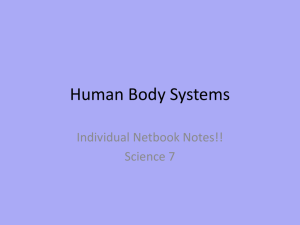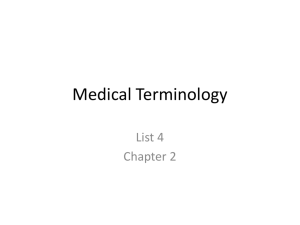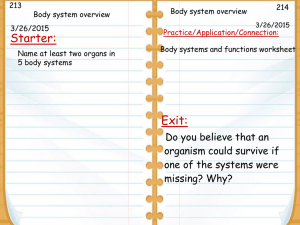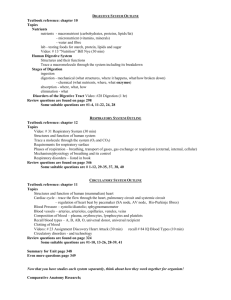Test Human Systems Pre AP
advertisement
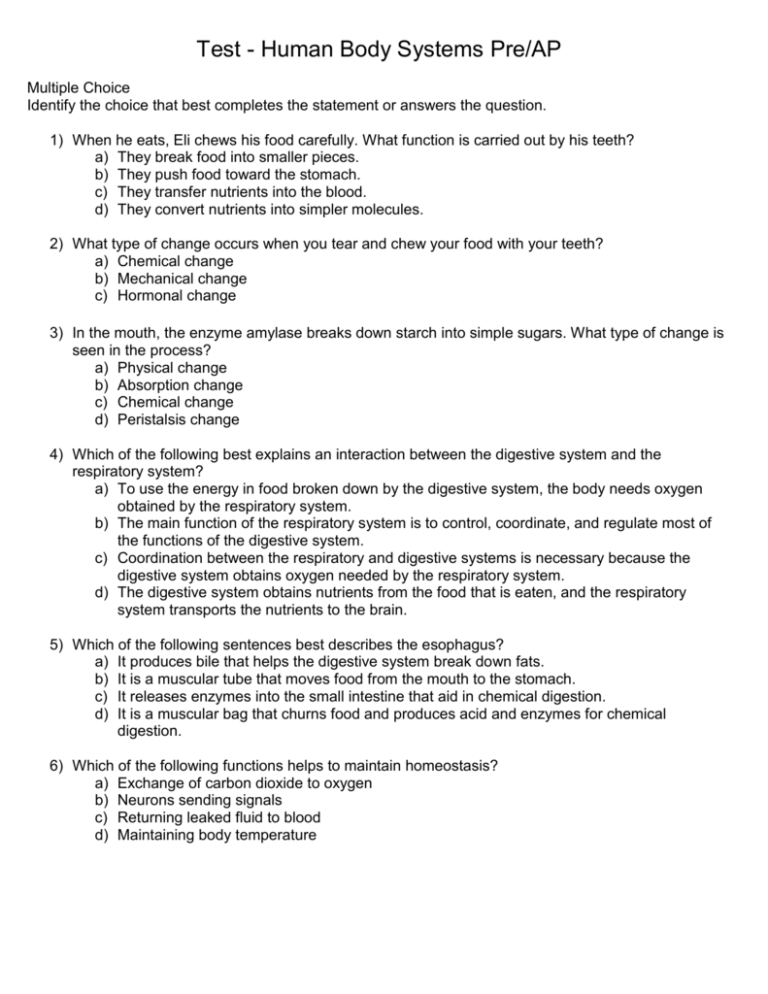
Test - Human Body Systems Pre/AP Multiple Choice Identify the choice that best completes the statement or answers the question. 1) When he eats, Eli chews his food carefully. What function is carried out by his teeth? a) They break food into smaller pieces. b) They push food toward the stomach. c) They transfer nutrients into the blood. d) They convert nutrients into simpler molecules. 2) What type of change occurs when you tear and chew your food with your teeth? a) Chemical change b) Mechanical change c) Hormonal change 3) In the mouth, the enzyme amylase breaks down starch into simple sugars. What type of change is seen in the process? a) Physical change b) Absorption change c) Chemical change d) Peristalsis change 4) Which of the following best explains an interaction between the digestive system and the respiratory system? a) To use the energy in food broken down by the digestive system, the body needs oxygen obtained by the respiratory system. b) The main function of the respiratory system is to control, coordinate, and regulate most of the functions of the digestive system. c) Coordination between the respiratory and digestive systems is necessary because the digestive system obtains oxygen needed by the respiratory system. d) The digestive system obtains nutrients from the food that is eaten, and the respiratory system transports the nutrients to the brain. 5) Which of the following sentences best describes the esophagus? a) It produces bile that helps the digestive system break down fats. b) It is a muscular tube that moves food from the mouth to the stomach. c) It releases enzymes into the small intestine that aid in chemical digestion. d) It is a muscular bag that churns food and produces acid and enzymes for chemical digestion. 6) Which of the following functions helps to maintain homeostasis? a) Exchange of carbon dioxide to oxygen b) Neurons sending signals c) Returning leaked fluid to blood d) Maintaining body temperature 7) The diagram above shows two important parts of the human digestive system. Which of these statements is correct? a) The majority of physical digestion take place in Part B. b) The pancreas releases enzymes into part A to aid in chemical digestion. c) As food digests, it moves through part B first, then through part A. d) Nutrients travel from the large intestine to the small intestine. 8) What is NOT one of the main functions of the endocrine system? a) Controls growth & development b) Controls Metabolism c) Maintains homeostasis d) Removes waste from the body 9) The diagram above shows some structures of the respiratory system. In which of the numbered structures are oxygen and carbon dioxide exchanged? a) 1 b) 2 c) 3 d) 4 10) The diagram shows the parts of a neuron. In what system does this belong? a) Excretory System b) Circulatory System c) Nervous System d) Integumentary System 11) Karla’s heart rate increases when she sees an alligator. Her endocrine system causes her heart rate to increase. How does the endocrine system send the message to increase the heart rate? a) It sends electrical signals through nerves to her heart. b) It sends hormones through her bloodstream to her heart. c) It sends cells through the tissues of her body to her heart. d) It sends chemical signals through axon terminals to her heart. 12) The bar graph shows how the height of a young person changed during a 5-year period. Which statement best explains this change? a) The nervous system regulated growth during the period to keep the growth rate steady. b) The endocrine system released hormones so the growth rate was steady over this period. c) The digestive system released more nutrients each year to cause the growth rate to increase. d) The circulatory system created more cells each year and caused the growth rate to increase. 13) The muscular system is made up of muscle tissue and accounts for almost half of a person’s body. What is muscle tissue? a) Tissue that is part of the skeletal system b) Tissue that is made up mainly of cartilage c) Tissue that is produced in the spongy part of bones d) Tissue that contracts and relaxes to produce movement 14) Sharon is working on a report on smooth muscles. Smooth muscles control involuntary body movements. Which of the following body structures is made up of smooth muscle? a) b) c) d) Lips Foot Upper arm Stomach 15) The following diagrams show two organ systems. How do these systems work together in the human body? a) System 1 breaks food down into nutrients, and system 2 transports the nutrients to cells in the body. b) System 2 breaks food down into nutrients, and system 1 transports the nutrients to cells in the body. c) System 1 takes in oxygen from the atmosphere, and system 2 transports the oxygen to cells in the body. d) System 2 takes in oxygen from the atmosphere, and system 1 transports the oxygen to cells in the body. 16) Sam had a disease that weakened his heart so it could not pump properly. This caused him to be fatigued because his cells couldn’t get the nutrients they needed. Based on this information, Sam’s disease primarily affected the functions of which two systems? a) Skeletal system and digestive system b) Muscular system and cardiovascular system c) Integumentary system and muscular system d) Excretory system and cardiovascular system 17) Which statement correctly describes the interaction of two body systems? a) The endocrine system transports wastes from cells to the urinary system for excretion. b) The digestive system transports nutrients to the integumentary system, which excretes wastes. c) The nervous system produces hormones that control the function of the reproductive system. d) The respiratory system obtains oxygen that is delivered to cells by the cardiovascular system. 18) The eyes receive visual signals from the environment. This information is transmitted to the brain. Which body system does this process describe? a) Nervous system b) Excretory system c) Lymphatic system d) Integumentary system 19) The human skeletal system is an example of how function depends on structure. Which statement describes the relationship between the structure and function of the human skeletal system? a) The skeletal system breaks down food into nutrients that the body can use. b) The skeletal system returns fluids to blood vessels and helps get rid of bacteria and viruses. c) The skeletal system provides a frame to support and protect the body and allows the body to move. d) The skeletal system receives information about the body and the environment and responds to that information. 20) Which two body systems work together to make movement possible? a) The skeletal and muscular systems b) The nervous and endocrine systems c) The lymphatic and immune systems d) The cardiovascular and respiratory systems 21) Which of the following functions is shared by both the integumentary system and the respiratory system? a) Digestion of food b) Elimination of wastes c) Regulation of the body's growth d) Circulation of oxygen through the body 22) Which of the following is a main function of the circulatory system? a) To send signals to the nervous system. b) To produce hormones for reproduction. c) To break down nutrients into a simpler form d) To transport oxygen to tissues throughout the body 23) A patient has swollen feet, ankles, and legs, and has pain in his lower back. Tests show the level of urea, a waste product, in the patient's urine has suddenly risen. Which body system is most likely not functioning properly? a) Nervous b) Digestive c) Reproductive d) Excretory 24) The illustration below shows four organ systems of the human body. Which of these systems controls the functions of the other three systems? a) System 1 b) System 2 c) System 3 d) System 4 25) The illustration above shows four systems of the human body. Which two organ systems work together to provide cells with oxygen and to remove carbon dioxide from the body? a) System 1 and system 2 b) System 1 and system 4 c) System 2 and system 3 d) System 3 and system 4 26) The system that is composed of several different structures, including the kidneys, bladder, ureter, urethra, and sphincter muscles, has what function? a) The intake of waste products b) The homeostasis of waste products c) The isolation of waste products d) The excretion of waste products 27) Which statement best describes the overall function of the human respiratory system? a) The heart pumps blood containing carbon dioxide into the lungs, which is carried out of the body. b) Air moves through the mouth or nose into the lungs. c) Oxygen is transferred into the blood, which circulates the gas throughout the body. d) Oxygen is taken into the lungs and exchanged for carbon dioxide, which is breathed out. ‘ 28) Examples of carbohydrates are: a) Starch, fruit and oil b) Meat, fish and oil c) Sugar, potatoes and pasta 29) The table above shows hormones and the results of their deficiencies. These hormones are produced by the — a) Endocrine system to regulate or change the activities of the blood cells b) Muscular system to control the growth and development of the skeletal system. c) Circulatory system to help the body digest certain substances d) Digestive system to maintain a person’s normal weight and height 30) Which of the following is NOT a function of the integumentary system? a) To provide the body’s first defense against infection b) To help maintain the body’s temperature c) To provide a means for toxins to leave the body. d) To transport nutrients throughout the body. 31) Most body systems provide a variety of functions. The functions of some systems even overlap. For example, one system protects the body, regulates body temperature, removes wastes from the body, and senses external stimuli. Which body system carries out all of these functions? a) Nervous b) Endocrine c) Muscular d) Integumentary 32) The graph below shows how the respiratory system changes as a person goes from resting, to running, to walking, to resting again. The respiration rate is the number of breaths a person takes per minute. Based on the graph, a function of the respiratory system is to — a) Decrease a person's heartbeat during heavy activity, and to decrease the flow of blood to areas that will fill with blood. b) Increase the breathing rate during heavy activity so that more carbon dioxide can be absorbed by respiratory cells. c) Deliver oxygen to cells for cellular respiration at different rates, so that different amounts of energy can be made when needed. d) Detect changes in the outside world through nerve impulses, and to send these impulses throughout the body. Work Problems: 33) A runner impacts the ground with a force on her heel of 200N. If she runs a distance of 300m, how much work does the runner do? a) 6000N C. b) 60000J c) 200N 34) Julia does 300 Joules of work to push a cart 15 meters. How much force did Julia exert? a) 4500N b) 4500J c) 20N d) 20J 35) A fork lift moves 34m carrying a 1023N box across the warehouse floor. How much work is done by the fork lift? a) 30N b) 30J c) 34782N d) 34782J 36) A force of 100 newton was necessary to lift a rock. A total of 150 joules of work was done. How far was the rock lifted? a) 1.5N b) 250 meters c) 1.5 meters d) 50J CPR: 37) When doing CPR how many compressions per minute must you do? a) 20 b) 30 c) 100
